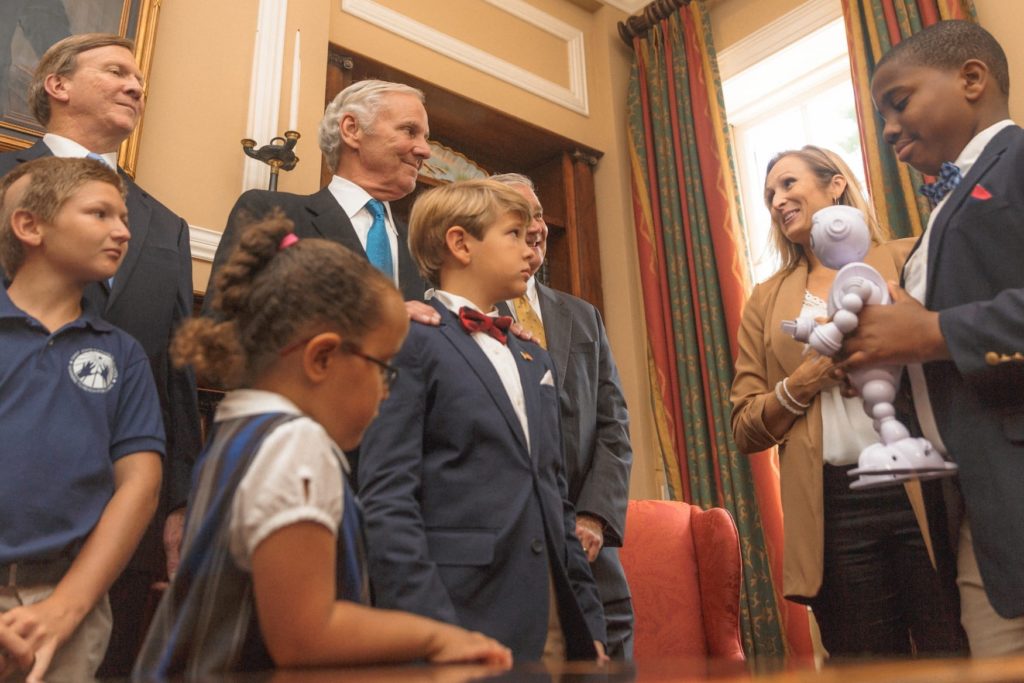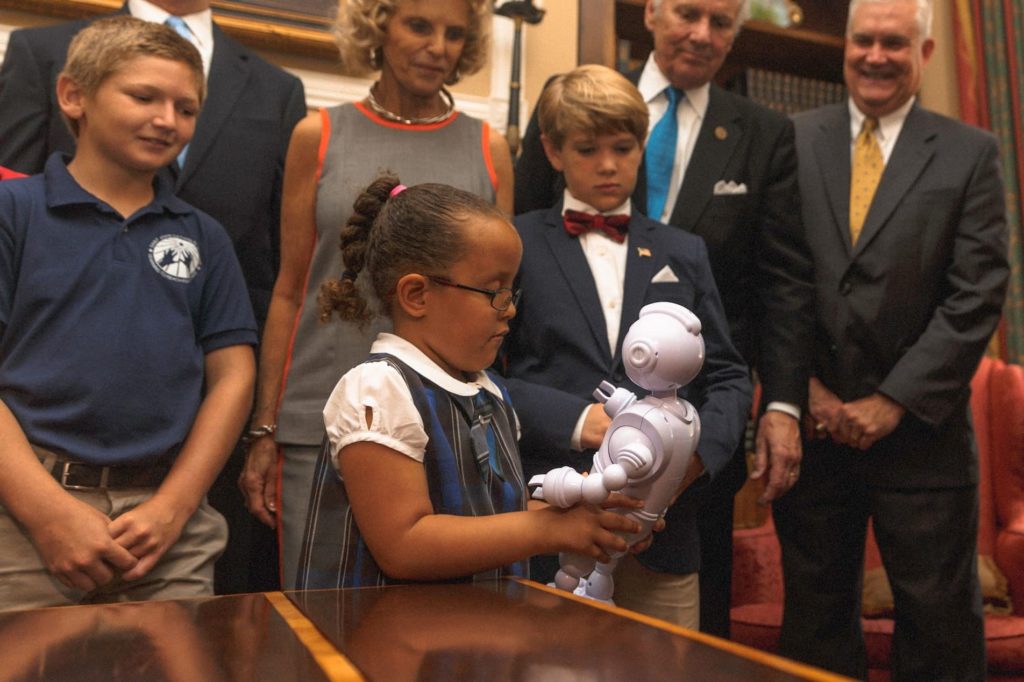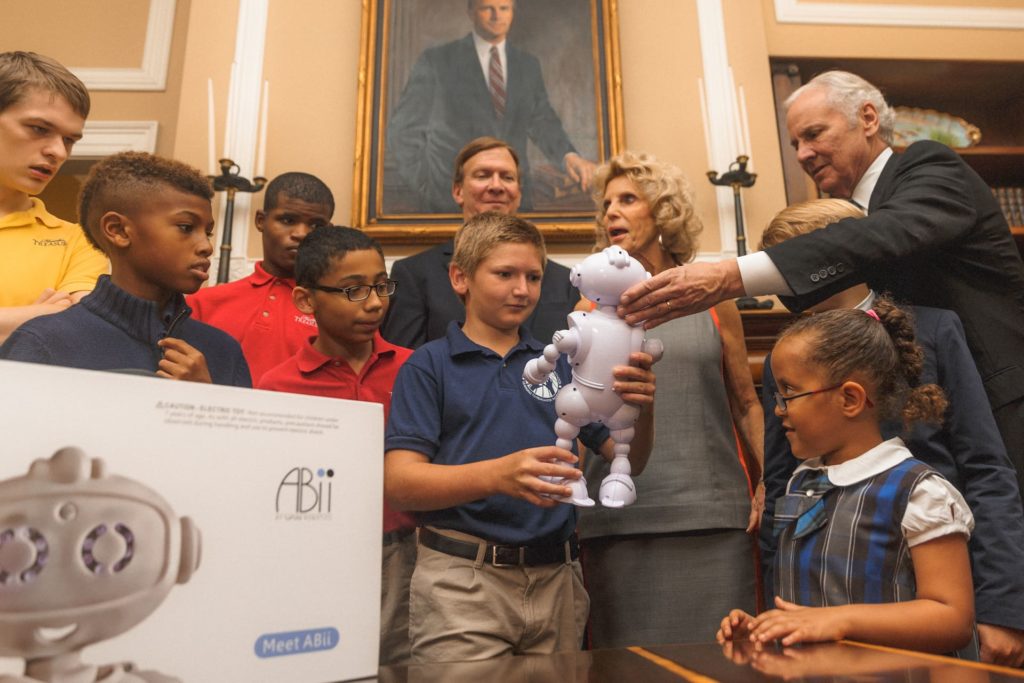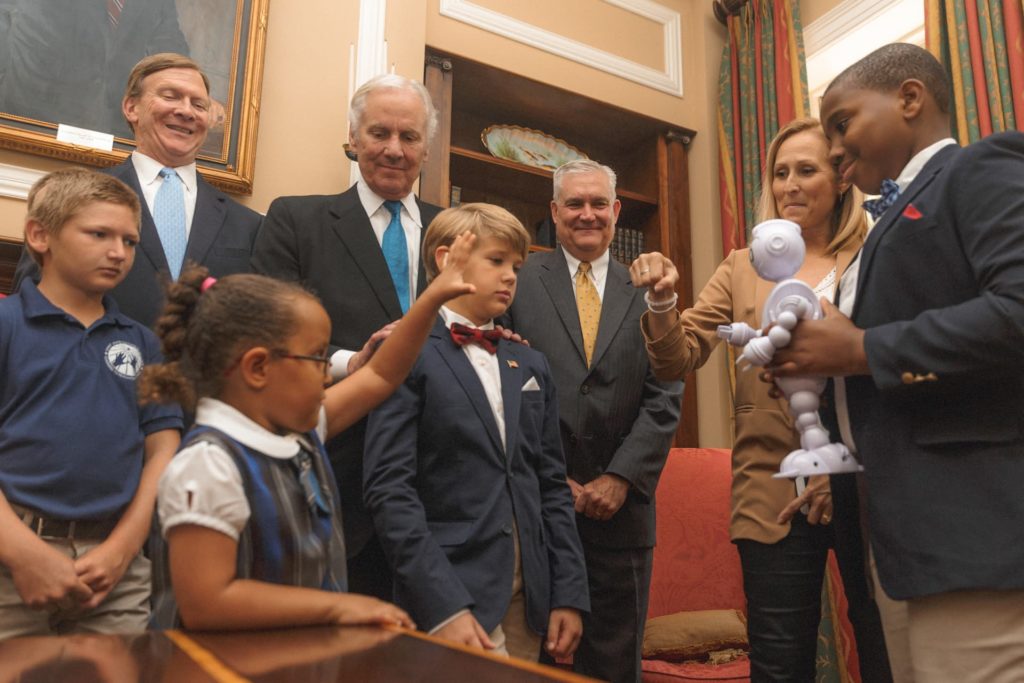The best education curriculum is often individualized, tailored to each student’s unique rate and style of learning. That can be hard to accomplish in a classroom full of 20-25 students, so many school districts around the country have begun turning to technologies that assist their teachers. The most sophisticated, smart classroom technologies include robots that leverage artificial intelligence to collect data about individual student learning and adapt to individual student needs and preferences.
Used properly, robots in education can help create a unique, personally tailored educational experience. This is especially true in situations where children are having a difficult time getting the attention they need. Robots are now being adopted as an effective way for teachers to provide more one-on-one time for students in their classrooms.

What Do Robots in the Classroom Look Like?
When technology was first introduced in classroom settings, it was found to be lacking. Educational apps loaded on Chromebooks and iPads promised students one-on-one interaction, but the results didn’t live up to expectations. Some of these apps simply asked students to read passages of information and then promptly quizzed students on what they had just read.
What seemed to be missing was the connection with students, based on adaptive social interactions that let the student know they “seen” and supported. That’s where robots offer some substantial benefits:
- Children tend to treat social robots — even non-humanoid ones — as though they are sentient and intelligent. This can help foster a bond between robots and students.
- Robots can be designed to sing and dance along with students. These robots help students learn by tapping into proven pedagogical strategies (students tend to retain information better when engaged with music, for example).
- Smart robots can collect environmental and social user data to address the whole student, not just their academic ability on a given day. With information about attention, stress level, and even how they’re feeling that day, a robot can engage with a student more appropriately than an app.
- Many educational robots can adopt several “personalities” depending on the student’s needs. Robots can then use body language to emphasize these personalities.
Robots can give children a fun, smart platform to engage with, succeeding in fostering interactivity where apps and iPads don’t.

Examples of Robots in the Classroom
Broadly speaking, there are numerous types of educational robots. Some of the simplest robot models look like little more than a couple of tennis balls sitting on top of a speaker. More complex robots incorporate human-like characteristics, such as faces, arms, and legs.
Students in our classrooms have diverse characteristics, representing a complex matrix of educational and social needs. The robots that are designed to engage with children, then, are likewise varied.
- Robots specifically for STEM: Many educational robots are designed specifically for use in Science, Technology, Engineering, and Mathematics (STEM) classes. These robots often include some type of coding or programming element. Sometimes these robots can look like a complicated toy, but they teach students valuable material. These types of programmable robots for schools have been around in some form or another for decades! But one common example of a modern version is the Dash and Dot robot programs, which are specifically designed for younger students.
- Robots for PreK-5: Many robots designed for elementary school ages are programmed to cover various aspects of the general education core curriculum. Many of these robots will tap into online databases to inform their instruction. It’s also not uncommon for these robots to use colorful personalities and characters as a way to more fully engage students.
- Robots for children with special needs: Many classroom robots can be adapted for use by children with special or extra needs. The specific educational approach can then evolve based on the needs of the student.

How Teachers Use Robots in the Classroom
Because robot tutors are becoming increasingly available, there’s some concern that teachers may somehow become obsolete. However, the role of the robot tutor is not to replace the teacher but instead, to help the teacher to augment instruction and provide additional data to allow for adaptive instruction to meet the needs of every child with personalized learning!
The best modern robot tutors, for example, work in concert with teachers’ lesson plans to augment what students are learning at every grade level. In the past few years, the educational value of this type of intervention has increased significantly. Features of educational robots include:
- Machine learning: The best robot tutors use artificial intelligence-guided algorithms to engage students with productive, challenging material.
- Tracking progress: Because smart robot tutors are connected to the internet, they can track and update student progress seamlessly. This progress can then be viewed by teachers or parents.
- Attention and emotion recognition: Facial recognition and high-resolution sensors combined with sophisticated, adaptive algorithms to create heightened emotional sensitivity. This can enable the robot to encourage younger pupils when they might be frustrated or overwhelmed by material, providing an essential emotional brace that can help encourage learning.
These characteristics have formed the bedrock foundation of ABii, Van Robotics’ premiere robot tutor. And ABii is one reason why robotics for kids has turned from curiosity to innovation.

How ABii Integrates with Classrooms
ABii is a brilliant example of what modern educational robots can achieve with students. In a classroom, ABii can teach individuals or small groups alike. Unlike some other robotic devices, ABii is rather anthropomorphic. She is designed to have a unique and engaging personality. Research has consistently shown that students respond better to a physical presence than they do to videos or abstract instruction.
So an anthropomorphized representation seemed the most appropriate, especially since ABii is designed specifically for K-5 education levels. What’s more, interacting with this type of robot can feel like playing a game, which can increase the number of fun students has.
In a classroom, ABii can evaluate students and spend extra time helping them practice core concepts. Because ABii can engage emotionally and track student progress, she has a good sense of when to push students to new material. She can also adapt to strategies that students respond to.

Responsive to Student Needs
This means that learning takes place at the student’s pace. That ability to let the student take the lead makes ABii among the most effective — and the most human — educational robots on the market today. In this way, students who need extra time can spend that time with ABii — no matter how much time it takes. What’s more, when a pupil gets frustrated or discouraged, ABii can respond by providing encouragement and emotional support.
Learning often entails a sense of struggle. Robot tutors, such as ABii, that can recognize those signs of a struggle and alter tactics or provide support lead to more successful students. One study found that students who used robot tutors improved their test scores by 52% (compared to 39% for students who did not use a robot tutor).

Steps to Set Up ABii in a Classroom
Large classrooms can present a challenge to both school districts eager to improve test scores and for teachers concerned about the education of their students. When introduced to a classroom, ABii can be used to improve information retention and student performance over time.
A teacher who wants to set up an ABii in their classroom will usually follow these steps:
- Select and review the curriculum for your classroom. Many teachers will often go through some of the material at least once in order to ensure it’s challenging and thorough enough for their students (these settings can be changed later).
- Review records to see which students might benefit most from spending time with ABii. In general, there are only so many ABii robots to go around. Some teachers will give every student equal access and opportunity, while others might find it more useful to prioritize students who are having difficulty with the material.
- Create student profiles for the ABii app. Once ABii knows who your students are, the robot can track progress, identify frustration points, and let teachers know which students are succeeding and who might need extra help.
- Get students comfortable with ABii. It’s true that these days, students tend to be exceptionally adept at using technology. But just as teachers would introduce any guest to the classroom, most will spend a little bit of time getting the students comfortable with ABii’s presence.
- Allow students to engage on their terms. As with any new situation, learning with ABii happens best in one-on-one settings. Some teachers will supervise the first interaction, while others let students take the lead.
- Review and revise: Because ABii tracks student progress in such detail, teachers have the opportunity to check up on each student and make sure they’re reaching their goals. If not, teachers can troubleshoot and make adjustments — either ahead of time or in real-time. ABii will make many of these adjustments herself, but teachers can leverage their experience and expertise to make choices as well.
In most cases, once ABii is up and running, teachers find that they might have more time for lesson planning, grading, and other classroom tasks. Additionally, teachers will then also have more time for students who might need more individualized attention.
By engaging with students as a tutor, ABii can help students stay caught up and meet educational goals.

An Adaptive Solution for Your Classroom
The bottom line is that educational robots such as ABii can help students succeed. And there’s nothing that’s more important, ultimately, than student success. That’s why robots have quickly become an essential part of educational environments. The best robots can augment the skills and efforts of educators, giving individualized and adaptive attention to students who need additional help.
When students are given extra time and extra attention, they succeed. A robot tutor can help create that one-on-one experience. Whether a teacher has 3 or 30 students, the right robots in the classroom make K-5 education more sensitive, more accessible and more successful.

No comments